The sieve trays market is forecasted to grow from USD 144 million in 2025 to USD 217 million by 2035, reflecting a compound annual growth rate (CAGR) of 4.2%. Sieve trays, which are essential components in distillation, absorption, and other separation processes, are crucial in industries such as chemical, petrochemical, and oil and gas. Their primary function is to provide efficient vapor-liquid contact within distillation columns, enhancing mass transfer efficiency. As global demand for refining processes increases, especially in the chemical and petrochemical sectors, the demand for high-performance sieve trays continues to rise. The market growth can be attributed to their ability to maximize efficiency while reducing energy consumption, which makes them indispensable in various industrial applications.
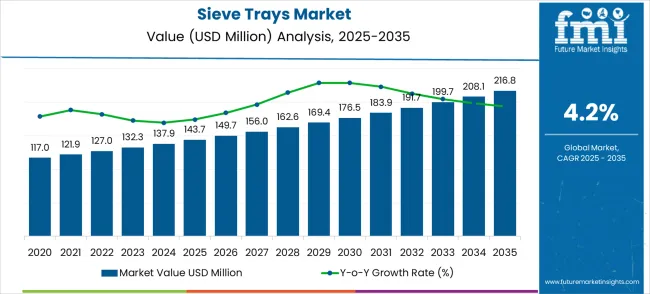
As industries continue to scale up production capacities and pursue more efficient processes, the sieve trays market is expected to expand. Their widespread use in industries like oil refining, natural gas processing, and chemical manufacturing ensures their ongoing relevance. The market's demand is also being influenced by the continued shift toward optimizing process technologies to meet both operational and environmental standards. With the increasing focus on reducing operational costs and improving productivity, sieve trays are seen as a key component in achieving these goals. The long-term growth of this market will be driven by industrial expansions, energy optimization efforts, and the pursuit of more sustainable and cost-effective separation technologies.
| Metric | Value |
|---|---|
| Estimated Value in (2025E) | USD 144 million |
| Forecast Value in (2035F) | USD 217 million |
| Forecast CAGR (2025 to 2035) | 4.2% |
The sieve trays market holds around 5.3% of the chemical process equipment market, driven by their use in distillation, absorption, and other separation processes. In the industrial filtration market, it captures a 6.7% share, as sieve trays are integral in maintaining efficient filtration systems in industries such as oil and gas, chemicals, and pharmaceuticals. Within the process equipment market, it represents a 4.9% share, as sieve trays are vital in the efficient separation of mixtures in industrial settings. The petrochemical industry equipment market contributes 3.8%, reflecting the demand for effective separation technology in refining and chemical processing plants. Lastly, the separation equipment market sees a 7.5% share, with sieve trays playing a crucial role in liquid and gas separation processes. These parent markets make up 28.2%, showcasing the crucial role of sieve trays in optimizing operations across multiple industrial sectors. Their widespread use in improving separation efficiency in diverse applications underscores their continued relevance and growth potential in the market.
Market expansion is being supported by the rapid increase in petrochemical refining capacity worldwide and the corresponding need for efficient separation equipment to optimize distillation processes. Modern refining operations rely on precise tray designs to achieve optimal vapor-liquid contact and maintain high separation efficiency across diverse hydrocarbon processing applications. Effective tray systems enable processors to maximize product yields, minimize energy consumption, and ensure consistent product quality while meeting stringent environmental regulations.
The growing complexity of refining processes and increasing focus on operational efficiency are driving demand for advanced sieve tray solutions from certified manufacturers with appropriate design capabilities and quality assurance. Chemical processing facilities are increasingly requiring sophisticated tray systems that can handle varying feed compositions while maintaining stable performance under different operating conditions. Industry standards and process optimization requirements are establishing standardized tray specifications that require precision manufacturing and specialized engineering expertise for optimal separation performance.
The market is segmented by material type, application, and region. By material type, the market is divided into stainless steel materials, carbon steel materials, titanium materials, and others. Based on application, the market is categorized into petrochemical processing, alcohol distillation, chemical manufacturing, and others. Regionally, the market is divided into North America, Europe, East Asia, South Asia Pacific, Latin America, and Middle East & Africa.
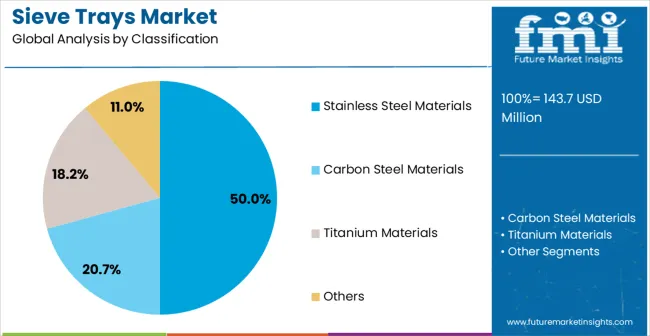
Stainless steel sieve trays are projected to account for 50.0% of the Sieve Trays market in 2025. This leading share is supported by the widespread adoption of stainless steel construction in chemical and petrochemical processing applications, which represent the majority of current market demand requiring corrosion resistance and durability. Stainless steel provides optimal performance characteristics while maintaining sufficient mechanical strength for most industrial distillation applications including hydrocarbon separation, chemical purification, and solvent recovery processes. The segment benefits from established manufacturing procedures and comprehensive material availability from multiple specialized suppliers. These materials offer superior corrosion resistance for aggressive chemical environments while ensuring consistent performance standards across processing facilities and maintaining competitive lifecycle costs.
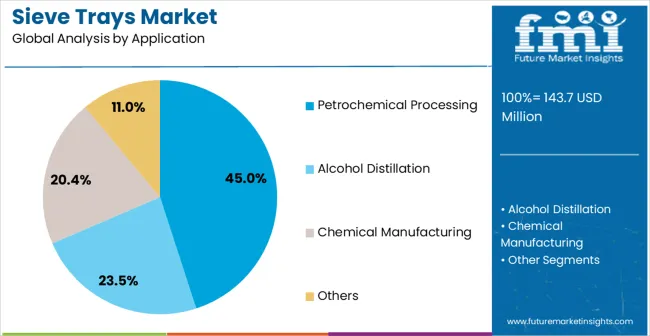
Petrochemical processing applications are expected to represent 45.0% of sieve tray demand in 2025. This dominant share reflects the extensive use of distillation technology in crude oil refining, natural gas processing, and petrochemical production that requires efficient hydrocarbon separation systems. Modern petrochemical facilities increasingly feature multiple distillation columns that require coordinated tray installations for optimal product fractionation and process efficiency optimization across diverse operating conditions. The segment benefits from growing refining capacity expansion and increasing regulatory requirements for product quality specifications supporting advanced separation technology adoption. Market expansion continues as processors seek efficient separation solutions for complex hydrocarbon mixtures and precision fractionation applications requiring reliable equipment performance and enhanced operational capabilities.
The sieve trays market is advancing steadily due to increasing petrochemical processing capacity and growing recognition of separation efficiency importance for plant performance optimization. However, the market faces challenges including material cost fluctuations, need for specialized design expertise, and varying process requirements across different applications and operating conditions. Technology standardization efforts and performance validation programs continue to influence equipment quality and manufacturing standards development patterns across the industry.
The growing deployment of advanced tray geometries is enabling improved mass transfer performance through optimized hole patterns, enhanced downcomer designs, and specialized weir configurations for maximum separation efficiency. Advanced tray systems equipped with proprietary design features provide optimal vapor-liquid contact while minimizing pressure drop for processors while expanding operational flexibility and throughput capabilities. These technologies are particularly valuable for complex separation applications and high-capacity processing facilities that require maximum efficiency without operational limitations and enhanced process performance.
Modern sieve tray manufacturers are incorporating corrosion-resistant alloys and specialized coating systems that improve equipment longevity and reduce maintenance requirements through enhanced chemical resistance and fouling prevention. Integration of advanced metallurgy and surface engineering enables more reliable operation in challenging process environments and comprehensive performance optimization across diverse chemical processing applications. Advanced material solutions also support environmental compliance initiatives while meeting growing demand for sustainable processing equipment and extended equipment service life requirements.
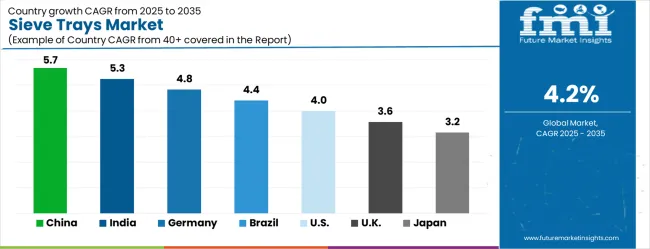
| Country | CAGR (2025-2035) |
|---|---|
| China | 5.7% |
| India | 5.3% |
| Germany | 4.8% |
| Brazil | 4.4% |
| United States | 4.0% |
| United Kingdom | 3.6% |
| Japan | 3.2% |
The sieve trays market is growing steadily, with China leading at a 5.7% CAGR through 2035, driven by massive petrochemical capacity expansion, growing refining infrastructure development, and comprehensive chemical industry modernization programs supporting advanced separation technology adoption. India follows at 5.3%, supported by expanding petrochemical sector and increasing government initiatives promoting chemical manufacturing and refining capacity development activities. Germany records 4.8%, emphasizing precision engineering, advanced manufacturing capabilities, and stringent process quality standards. Brazil grows at 4.4%, integrating modern separation systems into established refining operations and expanding chemical processing facilities. The United States shows 4.0% growth, focusing on process optimization and equipment replacement programs. The United Kingdom and Japan demonstrate steady growth at 3.6% and 3.2% respectively, driven by facility modernization and high-efficiency equipment adoption. The report covers an in-depth analysis of 40+ countries; top-performing countries are highlighted below.
The sieve trays market in China is growing at a CAGR of 5.7%, driven by the country’s expanding chemical, petrochemical, and pharmaceutical industries. As China continues to industrialize and modernize its manufacturing sectors, the demand for efficient separation equipment, such as sieve trays, is rising. The country's push for technological upgrades in industrial plants, along with a growing focus on optimizing production efficiency, is boosting the demand for high-performance sieve trays. Additionally, China’s significant role in global chemical production supports the need for advanced separation technologies to meet production demands.
The sieve trays market in India is projected to grow at a CAGR of 5.3%, supported by the country’s growing chemical, oil, and gas industries. As India modernizes its industrial infrastructure, there is an increasing demand for advanced separation technologies to improve production processes. Sieve trays are increasingly being adopted due to their superior efficiency in industrial applications like distillation, absorption, and stripping. With India’s expanding manufacturing base and the government's focus on industrial growth, the demand for high-quality separation technologies continues to rise.
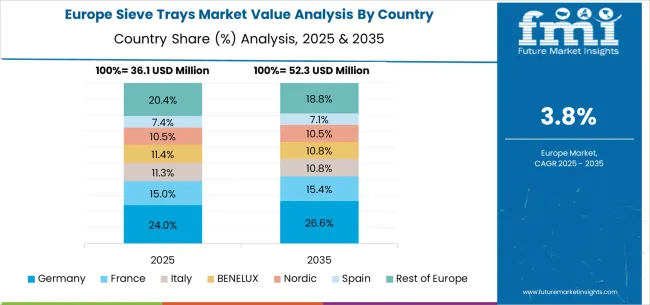
The sieve trays market in Germany is growing at a CAGR of 4.8%, supported by the country's advanced chemical and manufacturing sectors. Germany’s focus on improving industrial processes and efficiency is driving the demand for sieve trays, particularly in chemical and petrochemical plants. The country’s commitment to reducing operational costs and enhancing product quality in production facilities is further encouraging the adoption of high-performance separation equipment. Germany’s well-established manufacturing and industrial sectors continue to push the need for advanced technologies like sieve trays.
The sieve trays market in Brazil is projected to grow at a CAGR of 4.4%, driven by the country’s expanding chemical and petrochemical industries. As Brazil’s industrial sectors modernize and diversify, the demand for efficient separation equipment continues to rise. Sieve trays are gaining popularity for their superior separation capabilities in applications such as distillation and fractionation, particularly in the oil & gas sector. The Brazilian government’s focus on boosting industrial infrastructure and increasing energy production further accelerates the demand for advanced separation technologies.
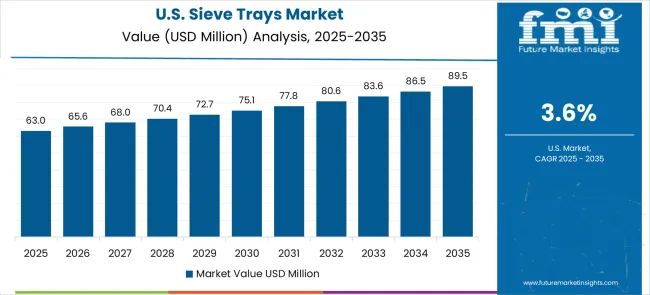
The sieve trays market in the United States is growing at a CAGR of 4.0%, driven by the country’s large-scale industrial applications in the chemical, pharmaceutical, and oil & gas industries. The demand for sieve trays is rising as industries seek to improve production efficiency and reduce operational costs. The U.S. market is characterized by a focus on optimizing existing production processes and adopting advanced technologies for separation in applications like distillation columns. Investments in energy efficiency and operational improvements continue to drive market growth.
The sieve trays market in the United Kingdom is growing at a CAGR of 3.6%, with steady adoption in the chemical, pharmaceutical, and food processing industries. The U.K. continues to focus on improving industrial processes and efficiency, driving the demand for sieve trays. In the pharmaceutical and chemical industries, sieve trays are increasingly used for separation processes in distillation and filtration. The U.K.’s focus on sustainable manufacturing practices and energy-efficient solutions continues to support the adoption of high-quality separation technologies like sieve trays.
The sieve trays market in Japan is expanding at a CAGR of 3.2%, supported by the country’s advanced manufacturing and chemical industries. Japan's demand for high-efficiency separation equipment in industrial applications is increasing, driven by the need for process optimization and cost-effective production. The adoption of sieve trays in industries such as chemicals, pharmaceuticals, and petrochemicals is rising, as companies continue to focus on enhancing product quality and reducing operational expenses. Japan’s industrial innovation and technological development continue to fuel the market for advanced separation technologies.
The sieve trays market in Europe is projected to grow from USD 38.5 million in 2025 to USD 55.8 million by 2035, registering a CAGR of 3.8% over the forecast period. Germany is expected to maintain its leadership with a 27.8% share in 2025, supported by its extensive chemical processing infrastructure and advanced manufacturing capabilities.
The United Kingdom is projected to hold 18.9% market share, followed by France at 15.7%. Italy and Spain account for 13.2% and 11.1% respectively. The Rest of Europe region represents 13.3% of the market, attributed to growing chemical industry investments in Eastern European countries and expanding refining capacity development across the region.
The Sieve Trays market is defined by competition among specialized equipment manufacturers, process engineering companies, and industrial fabrication suppliers. Companies are investing in advanced design technologies, manufacturing automation capabilities, quality assurance systems, and technical support services to deliver precise, reliable, and efficient separation solutions. Strategic partnerships, technological innovation, and geographic expansion are central to strengthening product portfolios and market presence.
Sulzer, Switzerland-based, offers comprehensive distillation tray systems with focus on advanced engineering, precision manufacturing, and technical expertise for complex separation applications. RVT Process Equipment, operating globally, provides specialized tray solutions integrated with complete distillation system capabilities for diverse industrial requirements. Kuber Precision Tech LLP, India, delivers technologically advanced tray manufacturing with standardized procedures and quality integration. AMT International Inc, U.S., emphasizes custom tray designs and comprehensive coverage for petrochemical processing applications.
AMACS, providing regional solutions, offers sieve tray manufacturing integrated with comprehensive process engineering services. Boegger Industech Limited and Mass Transfer Limited deliver specialized tray expertise with advanced technical capabilities and validation support. Saiptech, TPT Pacific (TPT), Raschig USA, Chemdist Group, Nantong Sutong Separation Technology, Sepco Process Inc., MTE Pratap Engineers, Ambani Metal, and Finepac offer specialized sieve tray manufacturing expertise, standardized production procedures, and technical reliability across regional and international industrial networks.
Sieve trays are critical mass transfer components in distillation columns, serving as the interface for vapor-liquid contact in petrochemical processing, alcohol distillation, and chemical manufacturing operations. With the market valued at $144 million in 2024 and projected to reach $217 million by 2030 at a 4.2% CAGR, this specialized sector is driven by capacity expansions in refining, chemical processing modernization, and stringent efficiency requirements. Success requires coordination between materials suppliers, precision manufacturers, process engineers, and end-users to deliver custom-engineered solutions that optimize separation performance while withstanding harsh operating conditions.
How Governments Could Support Industrial Infrastructure Development?
How Industry Organizations Could Enhance Technical Standards?
How Equipment Manufacturers Could Strengthen Capabilities?
How End-Users Could Optimize Performance?
How Process Engineers Could Drive Innovation?
How Financial Partners Could Enable Market Growth?
Strategic Consolidation Funding: Support industry consolidation that creates companies with broader technical capabilities, geographic reach, and manufacturing scale to serve global process industry customers.
| Item | Value |
|---|---|
| Quantitative Units (2025) | USD 144 million |
| Material Type | Stainless Steel Materials, Carbon Steel Materials, Titanium Materials, Others |
| Application | Petrochemical Processing, Alcohol Distillation, Chemical Manufacturing, Others |
| Regions Covered | North America, Europe, East Asia, South Asia & Pacific, Latin America, Middle East & Africa |
| Countries Covered | United States, Canada, United Kingdom, Germany, France, China, Japan, South Korea, India, Brazil, Australia and 40+ countries |
| Key Companies Profiled | Sulzer, RVT Process Equipment, Kuber Precision Tech LLP, AMT International Inc, AMACS, Boegger Industech Limited, Mass Transfer Limited, Saiptech, TPT Pacific (TPT), Raschig USA, Chemdist Group, Nantong Sutong Separation Technology, Sepco Process Inc., MTE Pratap Engineers, Ambani Metal, Finepac |
| Additional Attributes | Dollar sales by material type and application segments, regional demand trends across Asia-Pacific, North America, and Europe, competitive landscape with established manufacturers and emerging technology providers, customer preferences for stainless steel versus alternative material construction, integration with advanced distillation column systems and process optimization platforms, innovations in tray design technologies |
Region:
The global sieve trays market is estimated to be valued at USD 143.7 million in 2025.
The market size for the sieve trays market is projected to reach USD 216.8 million by 2035.
The sieve trays market is expected to grow at a 4.2% CAGR between 2025 and 2035.
The key product types in sieve trays market are stainless steel materials, carbon steel materials, titanium materials and others.
In terms of application, petrochemical processing segment to command 45.0% share in the sieve trays market in 2025.






Our Research Products

The "Full Research Suite" delivers actionable market intel, deep dives on markets or technologies, so clients act faster, cut risk, and unlock growth.

The Leaderboard benchmarks and ranks top vendors, classifying them as Established Leaders, Leading Challengers, or Disruptors & Challengers.

Locates where complements amplify value and substitutes erode it, forecasting net impact by horizon

We deliver granular, decision-grade intel: market sizing, 5-year forecasts, pricing, adoption, usage, revenue, and operational KPIs—plus competitor tracking, regulation, and value chains—across 60 countries broadly.

Spot the shifts before they hit your P&L. We track inflection points, adoption curves, pricing moves, and ecosystem plays to show where demand is heading, why it is changing, and what to do next across high-growth markets and disruptive tech

Real-time reads of user behavior. We track shifting priorities, perceptions of today’s and next-gen services, and provider experience, then pace how fast tech moves from trial to adoption, blending buyer, consumer, and channel inputs with social signals (#WhySwitch, #UX).

Partner with our analyst team to build a custom report designed around your business priorities. From analysing market trends to assessing competitors or crafting bespoke datasets, we tailor insights to your needs.
Supplier Intelligence
Discovery & Profiling
Capacity & Footprint
Performance & Risk
Compliance & Governance
Commercial Readiness
Who Supplies Whom
Scorecards & Shortlists
Playbooks & Docs
Category Intelligence
Definition & Scope
Demand & Use Cases
Cost Drivers
Market Structure
Supply Chain Map
Trade & Policy
Operating Norms
Deliverables
Buyer Intelligence
Account Basics
Spend & Scope
Procurement Model
Vendor Requirements
Terms & Policies
Entry Strategy
Pain Points & Triggers
Outputs
Pricing Analysis
Benchmarks
Trends
Should-Cost
Indexation
Landed Cost
Commercial Terms
Deliverables
Brand Analysis
Positioning & Value Prop
Share & Presence
Customer Evidence
Go-to-Market
Digital & Reputation
Compliance & Trust
KPIs & Gaps
Outputs
Full Research Suite comprises of:
Market outlook & trends analysis
Interviews & case studies
Strategic recommendations
Vendor profiles & capabilities analysis
5-year forecasts
8 regions and 60+ country-level data splits
Market segment data splits
12 months of continuous data updates
DELIVERED AS:
PDF EXCEL ONLINE
13X Molecular Sieve Activated Powder Market Size and Share Forecast Outlook 2025 to 2035
TPSS Special Molecular Sieve Activation Powder Market Size and Share Forecast Outlook 2025 to 2035
ESD Trays Market Size and Share Forecast Outlook 2025 to 2035
Lab Trays Market Size and Share Forecast Outlook 2025 to 2035
Meat Trays Market Analysis - Size and Share Forecast Outlook 2025 to 2035
Key Companies & Market Share in the Food Trays Sector
CPET Trays Market
Pharma Trays Market Size, Share & Forecast 2025 to 2035
Correx Trays Market
Insert Trays Market
Syringe Trays Market
PET Food Trays Market Size and Share Forecast Outlook 2025 to 2035
Assembly Trays Market Size and Share Forecast Outlook 2025 to 2035
Market Share Breakdown of Assembly Trays Manufacturers
Bakeable Trays Market
Cardboard Trays Market Size, Share & Forecast 2025 to 2035
Fibreglass Trays Market Size and Share Forecast Outlook 2025 to 2035
Dispensing Trays Market Size, Share & Forecast 2025 to 2035
Trach Care Trays Market
Autoclaving Trays Market Trends - Growth & Forecast 2025 to 2035

Thank you!
You will receive an email from our Business Development Manager. Please be sure to check your SPAM/JUNK folder too.
Chat With
MaRIA